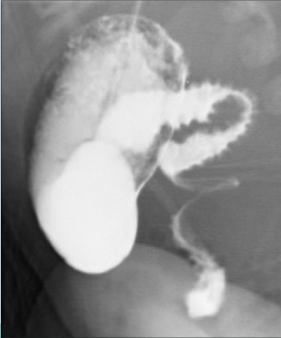[1]
Millar AJ,Rode H,Cywes S, Malrotation and volvulus in infancy and childhood. Seminars in pediatric surgery. 2003 Nov;
[PubMed PMID: 14655161]
[2]
Birajdar S,Rao SC,Bettenay F, Role of upper gastrointestinal contrast studies for suspected malrotation in neonatal population. Journal of paediatrics and child health. 2017 Jul;
[PubMed PMID: 28425590]
[4]
Sivakumar A,Mahadevan A,Lauer ME,Narvaez RJ,Ramesh S,Demler CM,Souchet NR,Hascall VC,Midura RJ,Garantziotis S,Frank DB,Kimata K,Kurpios NA, Midgut Laterality Is Driven by Hyaluronan on the Right. Developmental cell. 2018 Sep 10;
[PubMed PMID: 30174180]
[6]
Nagdeve NG,Qureshi AM,Bhingare PD,Shinde SK, Malrotation beyond infancy. Journal of pediatric surgery. 2012 Nov;
[PubMed PMID: 23163993]
[8]
Applegate KE,Anderson JM,Klatte EC, Intestinal malrotation in children: a problem-solving approach to the upper gastrointestinal series. Radiographics : a review publication of the Radiological Society of North America, Inc. 2006 Sep-Oct;
[PubMed PMID: 16973777]
[9]
Shah MR,Levin TL,Blumer SL,Berdon WE,Jan DM,Yousefzadeh DK, Volvulus of the entire small bowel with normal bowel fixation simulating malrotation and midgut volvulus. Pediatric radiology. 2015 Dec;
[PubMed PMID: 26209961]
[10]
Reddy AS,Shah RS,Kulkarni DR, Laparoscopic Ladd'S Procedure in Children: Challenges, Results, and Problems. Journal of Indian Association of Pediatric Surgeons. 2018 Apr-Jun;
[PubMed PMID: 29681694]
[11]
Tsumura H,Ichikawa T,Kagawa T,Nishihara M, Successful laparoscopic Ladd's procedure and appendectomy for intestinal malrotation with appendicitis. Surgical endoscopy. 2003 Apr;
[PubMed PMID: 12574927]
[12]
Isani MA,Schlieve C,Jackson J,Elizee M,Asuelime G,Rosenberg D,Kim ES, Is less more? Laparoscopic versus open Ladd's procedure in children with malrotation. The Journal of surgical research. 2018 Sep;
[PubMed PMID: 29937013]
[13]
Bass KD,Rothenberg SS,Chang JH, Laparoscopic Ladd's procedure in infants with malrotation. Journal of pediatric surgery. 1998 Feb;
[PubMed PMID: 9498402]
[14]
Arnaud AP,Suply E,Eaton S,Blackburn SC,Giuliani S,Curry JI,Cross KM,De Coppi P, Laparoscopic Ladd's procedure for malrotation in infants and children is still a controversial approach. Journal of pediatric surgery. 2018 Oct 28;
[PubMed PMID: 30442460]
[15]
Catania VD,Lauriti G,Pierro A,Zani A, Open versus laparoscopic approach for intestinal malrotation in infants and children: a systematic review and meta-analysis. Pediatric surgery international. 2016 Dec;
[PubMed PMID: 27709290]
Level 1 (high-level) evidence
[16]
Huntington JT,Lopez JJ,Mahida JB,Ambeba EJ,Asti L,Deans KJ,Minneci PC, Comparing laparoscopic versus open Ladd's procedure in pediatric patients. Journal of pediatric surgery. 2017 Jul;
[PubMed PMID: 27856011]
[17]
Kulaylat AN,Hollenbeak CS,Engbrecht BW,Dillon PW,Safford SD, The impact of children's hospital designation on outcomes in children with malrotation. Journal of pediatric surgery. 2015 Mar;
[PubMed PMID: 25746700]
[19]
Marseglia L,Manti S,D'Angelo G,Gitto E,Salpietro C,Centorrino A,Scalfari G,Santoro G,Impellizzeri P,Romeo C, Gastroesophageal reflux and congenital gastrointestinal malformations. World journal of gastroenterology. 2015 Jul 28;
[PubMed PMID: 26229394]

